Missing Metallic Asteroids Could Be Camouflaged As Normal Space Rocks

A special handful of asteroids that spacecraft have never visited seem to be massive hunks of metal, the nuggets of would-be planets that have lost their rocky outer layers.
But scientists can't find as many of these metal-rich asteroids as they suspect ought to exist, based on the number of iron meteorites that have landed in their laps here on Earth. Now, researchers simulating collisions in space think they may know why that is: These metallic bodies could wear thin shells of glassy rock born of collisions, making the objects appear, from Earth, like more-typical asteroids.
"There may be a kind of camouflage effect," Guy Libourel, a scientist at Observatoire de la Côte d'Azur in France and lead author on the paper detailing the findings, told Space.com. "They were simply hidden by this impact melt that made a kind of carpet on top of them."
Related: Photos: Asteroids in Deep Space
These metallic asteroids are intriguing because scientists think the objects may be miniature, naked planetary cores. That would make them much easier targets for scientists looking to understand their rock-coated equivalents, like the one deep below your feet.
"For the Earth or Mercury or Venus or the moon, we really don't have much information about the cores," Brandon Johnson, a planetary scientist at Purdue University in Indiana who wasn't involved in the new research, told Space.com. "If they are the cores of planetesimals, [they] let you look at what the core of a body actually looks like and you can study it in a laboratory, even, if you have iron meteorites."
And scientists do have iron meteorites, enough that researchers should have identified more metal-rich asteroids by now. That was the puzzle that Libourel and his colleagues wanted to tackle with the help of, essentially, a very large science gun that can mimic the collisions that take place regularly between the pieces of rubble speeding across the solar system.
Breaking space news, the latest updates on rocket launches, skywatching events and more!
The team turned to a special facility in Japan that can imitate such impacts in miniature. This device can blast a tiny rock pellet at speeds of around 3 miles (5 kilometers) per second into a metallic surface. In these reenactments, the researchers found that the rock seemed to melt and stick to the surface of the metal target, rather than simply scratching a dent in it. The findings seem to parallel observations of other asteroids, in which impacting objects have contaminated the surfaces, Johnson said.
In the simulations, the rock and metal even seemed to struggle to mix, Libourel said, comparing the behavior to oil and water. The result was a mix of smooth surfaces and patches of textured rubble on the mimicked asteroid. "You have spots of metal inside the glassy material," he said. "This is something that is brand new."
It's difficult to understand how such a comparatively tame experiment would play out on a real asteroid, which is much larger and sustains impacts over millions of years. Such collisions would also be more haphazard than the laboratory experiments, in which the micrometeorites hit the asteroid-like surface head on.

This kind of masquerade would presumably be difficult to track down using spacecraft, if there truly is no good way to detect metal-rich asteroids beneath their rocky shell. But NASA already plans to visit one of the objects scientists already believe is metal-rich, an asteroid called Psyche. The mission is scheduled to launch in 2022, arrive in 2026 and spend nearly two years circling the asteroid.
Scientists have plenty of experience getting a surprise when a mission arrives at an asteroid. Both NASA's OSIRIS-REx and Japan's Hayabusa2 missions approached their targets only to discover that they were much more boulder-strewn than predicted. But it's useful to try to figure out in advance what the spacecraft might see in order to best prepare for a mission, and simulations like those described in the new research could help scientists do just that.
"Libourel and his team are doing just the kind of work we need to anticipate some of the things we might see on Psyche," Lindy Elkins-Tanton, principal investigator of the Psyche mission and a planetary scientist at Arizona State University who wasn't involved in the experiments, wrote in an email to Space.com. "Imagine mounded metal crater edges, gaping chasms in the surround[ings], draped with silicate foam, all now cold and solid."
After all, there are seven long years to fill with imagined findings until the Psyche mission can start replacing hypotheses with data. In the meantime, Libourel and his colleagues said they are planning additional experimental collisions to try to refine the images scientists have of the metallic world. But it's entirely plausible that the spacecraft will find something entirely different than predicted by any such hypotheses.
"When I was reading this, my mind was just racing with what is Psyche really going to look like, and after this study, I am even more uncertain. So it will be really exciting to see the first images come back," Johnson said. "It's possible and likely that many people will be wrong. Or maybe everyone will be wrong, which is kind of the way discovery works."
The research is described in a paper published Wednesday (Aug. 28) in the journal Science Advances.
- NASA's Getting Ready to Explore the Corpse of an Ancient Planet in the Asteroid Belt
- NASA Unveils 2 New Missions to Study Truly Strange Asteroids
- Giant Metallic Asteroid Psyche May Have Water
Email Meghan Bartels at mbartels@space.com or follow her @meghanbartels. Follow us on Twitter @Spacedotcom and on Facebook.
Join our Space Forums to keep talking space on the latest missions, night sky and more! And if you have a news tip, correction or comment, let us know at: community@space.com.

Meghan is a senior writer at Space.com and has more than five years' experience as a science journalist based in New York City. She joined Space.com in July 2018, with previous writing published in outlets including Newsweek and Audubon. Meghan earned an MA in science journalism from New York University and a BA in classics from Georgetown University, and in her free time she enjoys reading and visiting museums. Follow her on Twitter at @meghanbartels.
